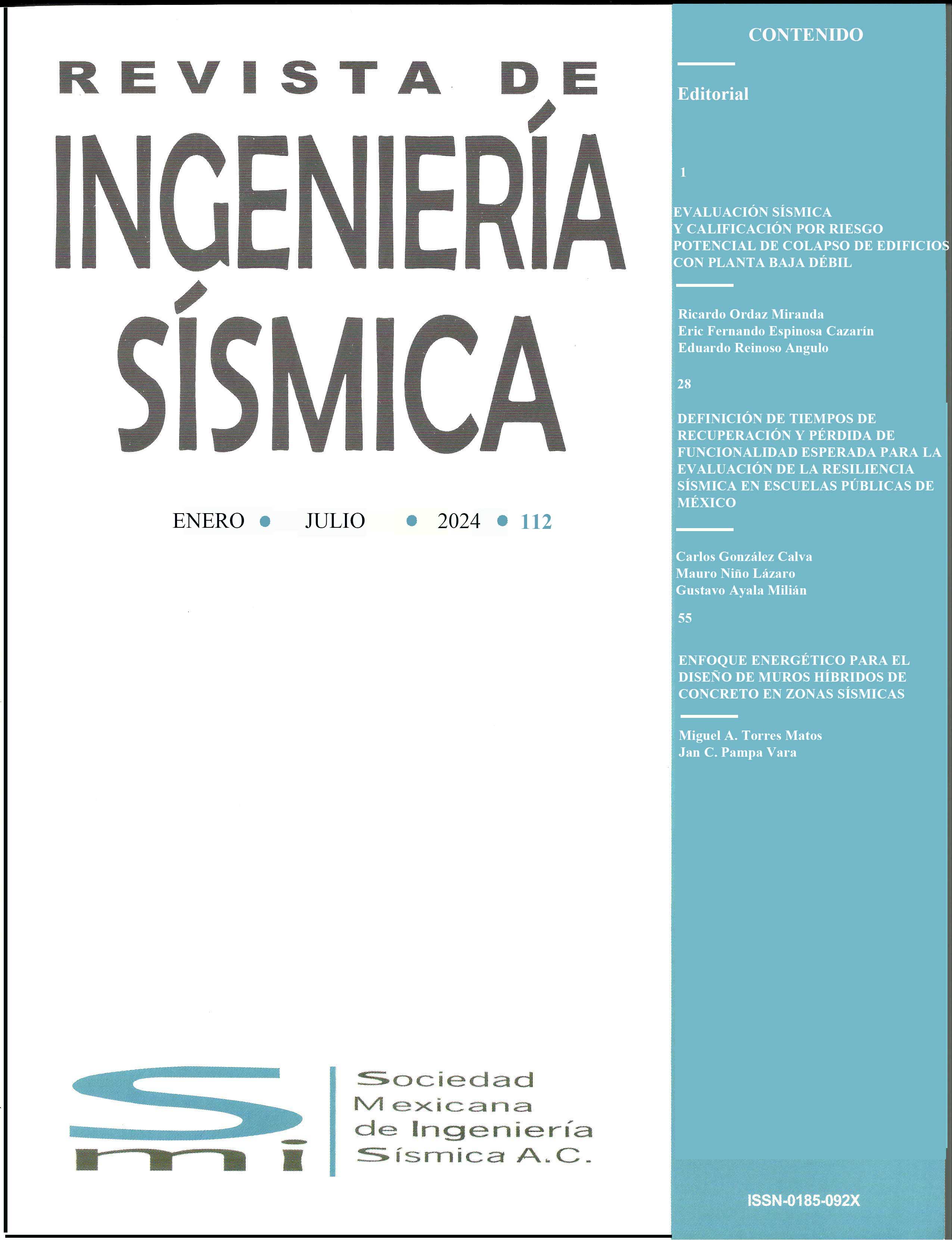EXPERIMENTAL BEHAVIOR OF CONNECTIONS FOR STEEL FRAMES UNDER SEISMIC DEMANDS
DOI:
https://doi.org/10.18867/ris.103.562Keywords:
steel frames, earthquake demands, connections, experimental test, ductilityAbstract
Cyclic inelastic behavior of six beam–column connections experimentally tested through natural-scale models are discussed. Selected configurations are widely employed in moment–resisting steel frame structures by the Mexican practice. According to the results, tested moment-resisting connections under large inelastic deformations demands developed an unexpected damage concentration that is not enough ductile for a high-ductility steel structure. The effect of various welding parameters and fabrications details are emphasized in order to improve the response of the connections under seismic demands.
Downloads
References
AISC-341 (2016), Seismic Provisions for Structural Steel Buildings, ANSI/AISC 341-16. American Institute of Steel Construction. Chicago, IL, USA.
AISC-358 (2016), Prequalified Connections for Special and Intermediate Steel Moment Frames for Seismic Applications, ANSI/AISC 358-16. American Institute of Steel Construction. Chicago, IL, USA.
AISC-360 (2016), Specification for Structural Steel Buildings, ANSI/AISC 360-16. American Institute of Steel Construction. Chicago, IL, USA.
AWS D8.1 (2009), Structural Welding Code – Seismic Supplement. An American National Standard. AWS D1.8/D1.8 M. American Welding Society D1 Committee on Structural Welding. 2nd edition.
Bertero V.V.; Anderson J.C. y Krawinkler H. (1994), “Performance of Steel Building Structures during the Northridge Earthquake Report No. UCB/EERC-94/09. Berkeley: Earthquake Engineering Research Center, University of California.
Engelhardt M.D. y Husain A.S. (1993), “Cyclic Loading Performance of Welded Flange-Bolted Web Connections”, Journal of Structural Engineering, American Society of Civil Engineers, Vol. 119. No. 12, pp. 3537-3550
FEMA-350 (2000), Recommended Seismic Design Criteria for New Steel Moment-Frame Buildings, FEMA-350, Federal Emergency Management Agency, Washington, DC.
FEMA-355C (2000), State of the Art Report on Systems Performance of Steel Moment Frames Subject to Earthquake Ground Shaking, FEMA-355C, prepared by the SAC Joint Venture for the Federal Emergency Management Agency, Washington, DC.
FEMA-355D (2000), State of the Art Report on Connection Performance, FEMA-355D, prepared by the SAC Joint Venture for the Federal Emergency Management Agency, Washington, DC.
FEMA-355F (2000), State of the Art Report on Performance Prediction and Evaluations of Steel Moment Frame Buildings, FEMA-355F, prepared by the SAC Joint Venture for the Federal Emergency Management Agency, Washington, DC.
Martín del Campo T., (2013), Estudio experimental de conexiones de acero a momento de vigas I con columna rectangular HSS, Tesis de maestría, Universidad Autónoma Metropolitana – Azcapotzalco.
NTC-DCEA-17 (2017), Normas Técnicas Complementarias para el Diseño y Construcción de Estructuras de Acero, Gaceta Oficial de la Ciudad de México, Vigésima época, No. 220 Bis, diciembre.
NTC-DS-17 (2017), Normas Técnicas Complementarias para el Diseño por Sismo, Gaceta Oficial de la Ciudad de México, Vigésima época, No. 220 Bis, diciembre.
Osteraas J. S.M. y Krawinkler H. (1989), “The Mexico Earthquake of September 19, 1985 – Behavior of Steel Buildings”, Earthquake Spectra, Vol. 5, No. 1. Pp. 51 – 88.
Popov E.P. y Tsai K.C. (1989) “Performance of Large Seismic Steel Moment Connections Under Cyclic Loads”, Engineering Journal, 2nd Quarter, American Institute of Steel Construction.
SAC (1995), “Interim Guideless: Evaluation, Repair, Modification and Design of Welded Steel Moment Frame Structures. Program to Reduce the Earthquake Hazards of Steel Moment Frame Structures. Federal Emergency Management Agency. Report FEMA 267/SAC-95-02. SAC Joint Venture. Sacramento, California.
SAC (1997), “Interim Guideless Advisory No. 1: Supplement to FEMA 267. Program to Reduce the Earthquake Hazards of Steel Moment Frame Structures. Federal Emergency Management Agency. Report FEMA 267A/SAC-96-03. SAC Joint Venture. Sacramento, California.
Santiago A. (2020), “Comportamiento de Conexiones de Acero Conforme a la Práctica Mexicana”, Tesis de Maestría, Universidad Nacional Autónoma de México. En proceso.
Tapia E. y Tena A. (2001), “Comparación de los efectos observados durante los sismos de México (1985), Northridge (1994) y Kobe (1995) y su impacto en las Normas de Diseño para Estructuras Metálicas del RCDF-2001”, Memorias, XIII Congreso Nacional de Ingeniería Sísmica, ID. IV-08. Guadalajara, Jal. Noviembre
Tapia E., García J.S., y Del Rincón A. (2016), "Estudio paramétrico del modelado inelástico de contravientos", Revista de Ingeniería Sísmica, SMIS. No. 94. Pp. 49-74. doi: dx.doi.org/10.18867/ris-0.
Tapia E. y García J.S. (2019), “Respuesta inelástica de marcos dúctiles con contraviento concéntrico”, Revista de Ingeniería Sísmica, SMIS. No. 100. Pp. 51-70. https://doi.org/10.18867/ris.100.478
Tapia E. y García J.S. (2019a), “Comportamiento de estructuras de acero durante los sismos de septiembre del 2017”, Revista de Ingeniería Sísmica, No. 101, pp. 36-52.
Tremblay R., Timler P., Bruneau M. y Filiatrault A., (1995), “Performance of steel structures during the 1994 Northridge earthquake”, Canadian Journal of Civil Engineering, Vol. 22, pp. 338-360.






